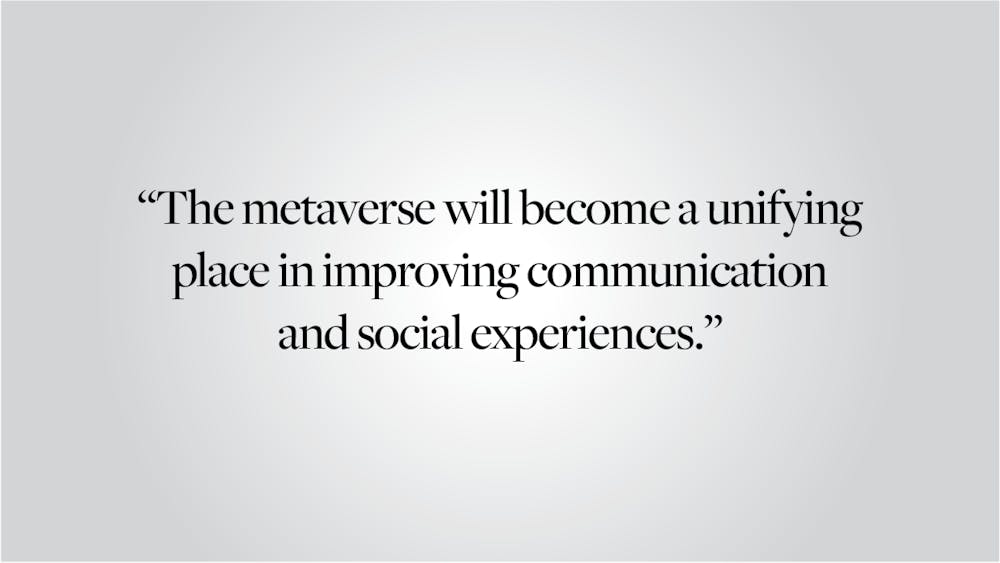Everyone’s favorite human being Mark Zuckerberg announced that Facebook would be changing its name to Meta in October. Although it may be true that this rebranding took place in response to the company’s widespread public demonization, the change also symbolizes Facebook’s expansion, along with many of its competitors, into a new frontier: the metaverse.
This new technology is more than the latest corporate buzzword. As our society shifts further toward reliance on digital means of collaboration and social interaction, the metaverse will become a unifying place in improving communication and social experiences. Though skeptics may question the necessity of a digital universe, arguing that it may lead society further down a dark, digital rabbit hole, in reality the metaverse is not here to replace physical interaction, but to supplement it.
Explaining the metaverse is like explaining the Internet in the 1970s. It is a new environment for digital communication, and while many agree that it could be the future of virtual interaction, no one quite knows what that reality will look like.
Broadly speaking, this new frontier can be understood as a form of virtual and augmented reality which combines elements of both the digital and physical worlds. Imagine a 3D city where avatars can work, play and interact, simulating a user’s real-time movement. The possibilities are endless — and developers are only beginning to scratch the surface.
For example, imagine Michael, a New York-based consultant who can now attend 3D virtual meetings with clients in Asia, as a lifelike, interactive avatar. These avatars mirror the real-time facial expressions and body language of users, simulating a traditional, in-person meeting. Or think about Lucy, a Shanghai-based music blogger who swipes through Instagram stories to find her friend at a concert in Los Angeles. With the wave of a hand, she can transport herself to the show in real time, dancing and engaging with the band as if she were there in person.
Skeptics question whether people will be incentivized to interact in virtual reality, considering that there are already effective means of communication in place, such as Zoom, social media platforms and of course, face-to-face interactions in the real world. But the metaverse has near-infinite possibilities, many of which transcend the capabilities of current platforms.
Michael and Lucy’s cases are hyper-realistic expansions of the most widely used facets of the Internet – business interaction, entertainment and social media. However, e-commerce may also emerge as an economic driver of the metaverse, in a similar way to how it drives the Internet — with a slight twist.
Users will be able to buy and sell virtual clothing, goods and even virtual “land” in the metaverse — items only to be used in the digital realm. These digital commodities, traded and owned using NFT technology, can be anything from a stylish hat for your avatar to an apartment in “Decentraland,” a virtual location in the metaverse. The market for goods and services in the metaverse will soon be worth $1 trillion, according to digital asset management firm Grayscale.
Social media has contributed to a worsening mental health crisis in America — something the metaverse may help to alleviate. Over three-quarters of Americans have a social media profile, spending on average more than 1300 hours on platforms last year. This behavior has been shown to cause increased depression and anxiety, according to Healthline. Now imagine that instead of going on a solitary late-night Instagram scrolling binge, comparing others’ curated “realities” to your own, your social media usage may shift to sharing synchronous conversations and virtual experiences with friends that closely mirror in-person interactions. This would surely be a step in combating the depression-inducing relationships which can be fostered by current social media platforms.
Even for those who don’t find themselves mindlessly scrolling, but instead choose to interact via call or text, the metaverse will serve to personify social interactions on the web, bringing friends into a common digital world and adding a previously unattainable layer of tangibility unbound by physical distance.
Beyond the fear of a “Ready Player One” dystopian future, critics of the metaverse remain skeptical of its implementation and accessibility. A VR headset is required to enter the metaverse, setting an eager new user back about $300. Though, as companies like Meta continue to invest billions into developing affordable and unobtrusive hardware, these barriers will begin to fade away. The metaverse continues to gain users and interest as an economic powerhouse, incentivizing VR companies to invest in hardware accessibility.
What remains to be seen is how individuals and companies will creatively build out these digital worlds. Web developers will continue to make remarkably fast progress as more and more users log on, eventually reaching a tipping point where, like the Internet today, the metaverse will become the standard for digital interaction. Love him or hate him, Zuckerberg is paving the way for a more interactive digital future.
Spencer Barnett ’24 can be reached at spencer_barnett@brown.edu. Please send responses to this opinion to letters@browndailyherald.com and other op-eds to opinions@browndailyherald.com.





